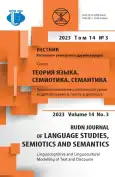Linguopragmatic Scopes of Modern Media Texts
- 作者: Akhrenova N.A.1,2, Zaripov R.I.3
-
隶属关系:
- State University of Humanities and Social Studies
- Moscow Region State Pedagogical University
- Prince Alexander Nevsky Military University of the Ministry of Defense of the Russian Federation
- 期: 卷 14, 编号 3 (2023): LINGUOCOGNITIVE AND LINGUOCULTURAL MODELLING OF TEXT AND DISCOURSE
- 页面: 801-817
- 栏目: SEMANTICS AND SEMIOTICS
- URL: https://journal-vniispk.ru/2313-2299/article/view/323419
- DOI: https://doi.org/10.22363/2313-2299-2023-14-3-801-817
- EDN: https://elibrary.ru/JLFRHH
- ID: 323419
如何引用文章
全文:
详细
The study is devoted to the description of the linguopragmatic potential of media texts in the context of the informational and psychological impact on the individual and collective addressee of mass information broadcasting. As the key modern form of text existence in the information space, a media text contains not only verbal elements that influence the audience through either spoken or written words, but also non-verbal ones, introduced through video, picture and various sound means other than speech. The combined combination of communicative means of linguistic and non-linguistic nature enhances the information-psychological impact on the audience by achieving a synergistic effect. Due to the fact that with the complex use of verbal and non-verbal means, the media text acquires such essential characteristics as polycode and multimodality, its analysis should take into account not only the linguistic proper, but also the extralinguistic aspects of communication. Modern media text has a complex communicative structure that combines a text, hypertext, dynamic (static) image and sound, and provides a non-linear, multi-channel, multi-layered and multidimensional perception of the embedded conceptual and stylistic meanings. The aim of the study is to analyze linguopragmatic characteristics of a media text as the primary form of the informational and psychological impact realization in the modern mass media discourse. Descriptive, synchronic, diachronic and functional methods of research, as well as methods of contextual and communicative-pragmatic analysis have been employed. As to the material, the study is based on the analysis of theoretical works by Russian and foreign linguists for the past 30 years. The authors concluded that the information-psychological impact is enhanced by the use of PR and advertising techniques in the media text and is largely based on their application.
作者简介
Natalia Akhrenova
State University of Humanities and Social Studies; Moscow Region State Pedagogical University
编辑信件的主要联系方式.
Email: nakhrenova@mail.ru
ORCID iD: 0000-0002-1265-5595
D.Sc. (Philology), Associate Professor, Professor of the Department of Germanic-Romance Languages of the Faculty of Foreign Languages, State University of Humanities and Social Studies; a.i. of the Translation and Cognitive Linguistics Department, State University of Education
30, Zelyonaya street, Kolomna, Russian Federation, 140410; 24, Very Voloshinoy street, Mytishi, Russian Federation, 141014Ruslan Zaripov
Prince Alexander Nevsky Military University of the Ministry of Defense of the Russian Federation
Email: lieutenant-en-chef@ya.ru
ORCID iD: 0000-0001-9980-7928
PhD in Philology, doctoral candidate
14, Bol’shaya Sadovaya, Moscow, Russian Federation, 111033参考
- McLuhan, M. (1962). The Gutenberg Galaxy: The Making of Typographic Man. Toronto: University of Toronto Press.
- McLuhan, M. (2015). The Gutenberg Galaxy: The Making of Typographic Man. Moscow: Akademicheskiy proekt. (In Russ.).
- Belyakov, I.M. & Maksimenko, O.I. (2009). Videoverbal text: problems of perception. Philological Sciences in MGIMO, 38(53), 48-57. (In Russ.).
- Chernyavskaya, V.E. (2009). Polycode text space: linguo-semiotic paradigm of linguistics. In: Language in the paradigms of humanitarian knowledge: XXI century. St. Petersburg: Lingua. pp. 23-37. (In Russ.).
- Sabadin, S.T.M.Zh.P. (2022). Mixed Texts: Creolized vs Polycode vs Multimodal. Philology. Theory & Practice, 15(6), 2017-2023. https://doi.org/10.30853/phil20220297 (In Russ.).
- Evgrafova, Yu.A. (2020). Black Mirror: Linguistic Semiotic Potential of Screen Texts: Monograph. (In Russ.).
- Milyakova, V.V. (2022). Persuasive characteristics of advertising texts [dissertation]. Mytishchi. (In Russ.).
- Baranov, A.N. (2013). Linguistic examination of the text: theoretical foundations and practice. Moscow: Flinta: Nauka. (In Russ.).
- Voroshilova, M.B. (2013). Creolized Text: Principle of Integrity or Principle of Replaceability. Political Linguistics, 4(46), 177-183. (In Russ.).
- Voroshilova, M.B. (2013). Political creolized text: keys to reading: a monograph. (In Russ.).
- Zelinsky, S.A. (2008). Information and psychological impact on mass consciousness. The means of mass communication, information and propaganda - as a conductor of manipulative methods of influencing the subconscious and modeling the actions of the individual and the masses. St. Petersburg: Skifia. (In Russ.).
- Dobrosklonskaya, T.G. (2008). Medialinguistics: a systematic approach to the study of the language of the media: modern English media speech. Moscow: Flinta: Nauka. (In Russ.).
- Skovorodnikov, A.P. & Kopnina, G.A. (2016). Linguistics of Information-Psychological War: on Substantiation and Definition of The Term. Political Linguistics, 1(55), 42-50. (In Russ.).
- Cluzel du, F. (2020). Cognitive Warfare. Innovation Hub, June-November, 6. URL: https://www.innovationhub-act.org/sites/default/files/2021-01/20210122_CW%20Final.pdf (accessed: 16.11.2022).
- Akhrenova, N.A. (2016). Internet-Discourse as a Hypertext. Bulletin of Moscow Region State University, 3, 1-12. (In Russ.).
- Nikolaeva, T.M. (1990). Text. In: Linguistic Encyclopedic Dictionary. Moscow: Sovetskaya entsiklopediya. p. 507. (In Russ.).
- Lee, S.J. & Reeves, T.C. (2018). Edgar Dale and the Cone of Experience. In: West, Richard E. Foundations of Learning and Instructional Design Technology: Historical Roots and Current Trends. Provo: Brigham Young University. URL: https://open.byu.edu/lidtfoundations/edgar_dale (accessed: 21.10.2022).
- Dale, E. (1954). Audio-visual methods in teaching. New York: The Dryden Press.
- Maksimenko, O.I. (2012). Polycode vs. Creolized Text: Terminology Problems. RUDN Journal of Language Studies, Semiotics and Semantics, 2, 93-102. (In Russ.).
- Golitsyn, G.A. & Petrov, V.M. (2007). Information. Behavior. Language. Creation. Moscow: LKI Publ. (In Russ.).
- Panarin, I.N. (2012). Media, propaganda and information wars. Moscow: Pokolenie. (In Russ.).
- Pirogova, Yu.K. (2001). Strategies of communicative influence in advertising: the experience of typology. In: Proceedings of the scientific conference “Dialogue 2001”. URL: https://www.dialog-21.ru/digest/2001/articles/pirogova/ (accessed: 11.11.2022). (In Russ.).
- Pease, A. (2000). Questions are the Answers. How to Get to “Yes” in Network Marketing. New South Wales: Pease Training International Pty.
- Sukhoterin, L. & Yudintsev, I. (2007). Information work in the state apparatus. Moscow: Evropa. (In Russ.).
- Kara-Murza, S.G. (2005). Mind manipulation. Moscow: Eksmo. (In Russ.).
- Ilyakhov, M. (2021). It is clear, it is clear: How to convey thoughts and encourage people with the help of words. Moscow: Alpina Publisher. (In Russ.).
补充文件









